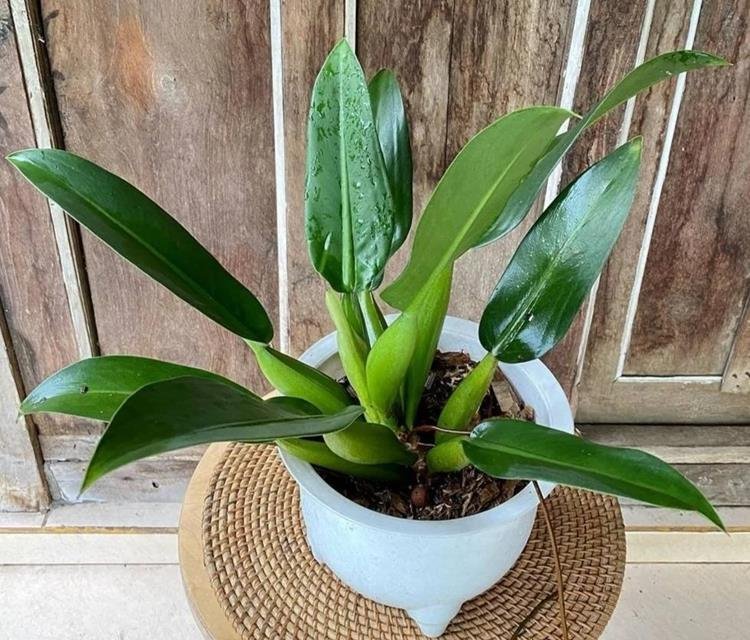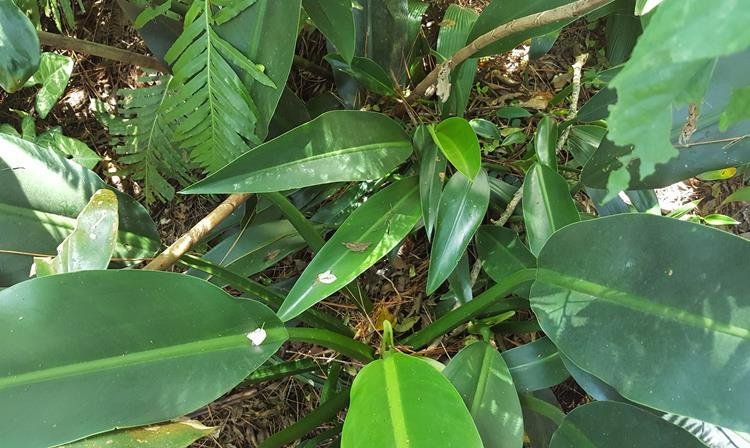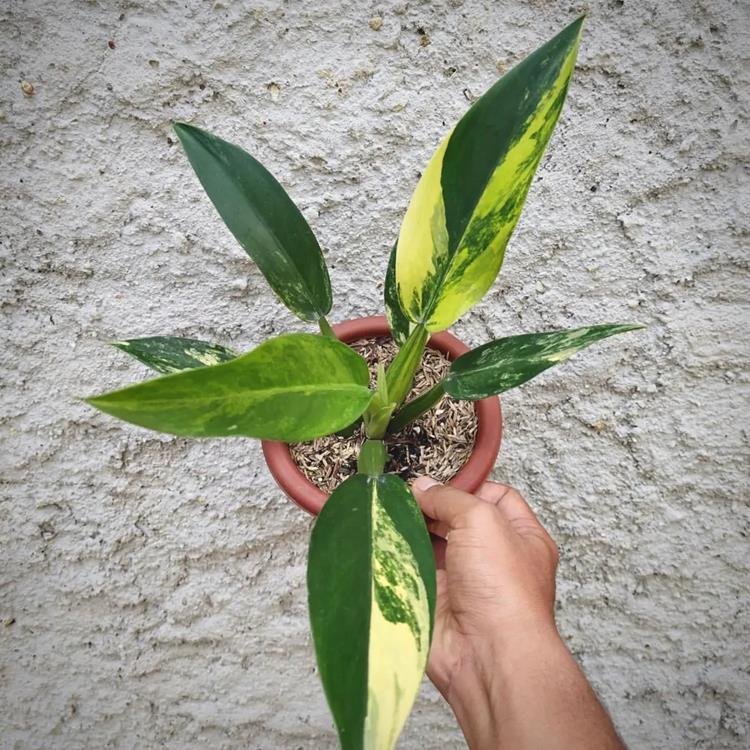Philodendron martianum (Philodendron Fat Boy) is a rare, easy-to-care houseplant that will give your home or office a tropical appeal. We bet you will love the dense, rosette-arranged, thick lance-shaped or lance-shaped-oblong leaves with swollen petioles.
Learn more about Philodendron martianum, including its looks (leaves, stems, and flowers), care needs, and how to propagate it. We will also give you insight into its prices, variegated form, and where to buy it.

About Philodendron martianum
Philodendron martianum Engl. is an accepted species described in 1899 by Heinrich Gustav Adolf Engler (1844-1930), a German botanist.
- Scientific name: Philodendron martianum
- Synonym: Philodendron cannifolium Mart. ex Kunth
- Common name: Martianum Philodendron, pacová, flask philodendron, Von Martius Philodendron, Philodendron Fat Belly, Philodendron Fatboy
- Family: Araceae
- Natural habitat: Brazil (Northeast, South, and Southeast)
- Toxicity: Mild to moderately toxic to cats, dogs, and humans since it has insoluble calcium oxalate, an irritant.
1. Growing habits, size, and growth rate
Philodendron martianum grows mainly as an epiphyte but can grow terrestrially if the tree it was growing on falls. It occurs mostly in the seasonally dry tropical biome, including the Atlantic rainforests and Restinga forests at altitudes of up to 2950 ft (900m) above mean sea level.
This aroid has a moderately fast growth rate, especially if grown under ideal conditions. It can grow to over 6.6 feet.
2. How to identify Philodendron martianum?
To identify this plant, consider the stems, leaves, and flowers if you find a mature one with blooms.
a). Stems
It has short, thick, semi-glossy, medium-green stems with short internodes whose epidermis eventually turns brown. Cataphylls are unribbed, persist initially but soon fall, i.e., they will still be present in the top few leaves.
b). Leaves
Philodendron martianum has rosette, dense, large (13.8-25.6″ long by 5.5-7.9″ wide), thick, leathery, lance-shaped or lance-shaped oblong leaves, semi-glossy and dark-green above, matte and moderately pale below. Apex is shortly acuminate, and the base sub-truncated to obtuse.
These leaves have a midrib that is wider and broadly flat-raised at the base but narrows towards the apex and is broadly convex, while primary lateral veins are thin and join near the cartilaginous margin.
Lastly, this aroid has swollen, moderately spongy, subterete medium green petioles with shallowly sulcate to obtusely flat above. These leaf stalks measure up to 15.7 inches and have strongly concave basal sheaths whose margins bend inwards, covering a hollow.

c). Philodendron martianum flower
Mature Philodendron martianum plants will have a single inflorescence per axil with the terete peduncle, a spadix, and a spathe (surrounding bract).
The spathe is boat-shaped, cuspidate, thick, and leathery. The blade is greenish-white (inside and out), and the tube is greenish, yellow-green, or greenish-cream outside and reddish-purple inside.
Once they mature, infructescence has dirty yellow berries with elliptic, dirty yellowish striate seeds.
Philodendron martianum variegated plants
If you don’t prefer standard green plants, you can go for variegated Philodendron martianum. These plants have green leaves with creamy-white (Albo) or yellow-green (aurea) variegation (streaks, sectors, or marblings). However, they are extremely rare and hard to find.
The care needs of the variegated martianum plants are similar to the green form. However, it would be best to stick to bright, indirect light and keep humidity at no less than 50%. The variegated areas tend to be vulnerable.
Lastly, variegated plants are expensive, starting at $200 onwards.

Caring for Philodendron martianum
Philodendron martianum grows best in a warm, humid place with bright, indirect light. Its potting soil should be airy, well-drained, and fertile, and you should only water it when the top few inches feel dry. It doesn’t like much water.
Don’t forget it needs repotting, feeding, and pruning. However, you don’t have to stake it.
Here is how to care for your Philodendron Fat Boy:
1. What are the ideal growing conditions?
Philodendron Fat Boy grows best in a warm (55-85°F) humid (40% RH or more) with bright indirect light. Avoid cold drafts, spots near heat sources or vents, or sudden temperature changes.
Direct sunlight will burn leaves, while very light will slow growth and make them have smaller, paler leaves. Consider investing in grow lights if you have a poorly lit room.
People in areas with very low humidity need to mist this plant, have a pebble tray, or buy a humidifier. Also, you can group your plants or move them to a humid room.
Lastly, outdoors in tropical and humid subtropical regions, USDA hardiness 10-11, grow it in a shaded area. This plant is not frost-hardy and cannot withstand freezing temperatures long.
2. Best soil or potting mix
The best soil should be well-drained, aerated, and high in organic matter with a slightly acidic to neutral pH. You can buy an aroid mix. Etsy.com has good stuff.
Alternatively, add some perlite, coco coir (or peat moss), bark chips, and worm casting to your potting soil. A little horticultural charcoal will be ok.
3. How should you water your Philodendron Fat Boy?
Watering is one area you cannot afford to go wrong. These plants don’t like sitting on wet soil. Also, allowing the potting mix to bone dry is detrimental.
I water my P. martianum when my soil moisture meter (XLUX) reads dry (three or less) or when the potting mix feels dry past the first knuckle of my finger. Don’t follow a watering schedule, as water needs vary.
Lastly, when watering, I slowly saturate the potting mix until excess water flows from drainage holes. After 15 minutes, I discard any that collects on the saucer.
3. Does Philodendron martianum need feeding or not?
Yes, but moderately. I feed this aroid with a balanced, liquid houseplant fertilizer at least once a month during the growing months. Miracle-Gro is an excellent pick; you can apply it with each watering.
I have also experimented with various brands for potted or houseplants, including unbalanced or slow-release, and they work well. So, Espoma, Joyful Dirt, Osmocote, Jobe’s, J. R. Peters, etc., are perfect.
4. More care needs
- Pruning: It requires very little pruning. However, check for and remove dead, damaged, and diseased leaves using sterilized gardening scissors.
- Repotting: I usually repot this plant after 1-2 years or if rootbound. Use a pot 2-3 inches wider in diameter.
- Support: Since this is a self-heading plant with relatively thick stems, you don’t have to give it a moss pole or trellis. It can grow terrestrially just fine.
How to propagate Philodendron martianum
You can propagate Philodendron martianum via division (if it has suckers), stem cutting (in water or soil), or using seeds. Seeds are very hard to find, and for stem cutting, you need a plant whose stem has several nodes.
I love water propagation, and here is what you need and how to go about it:
a). What you need
- Glass jar
- Gardening scissors
- 70-99% rubbing alcohol or any other sterilizing agent
- Rooting hormone. Not mandatory, but it will make rooting faster. Also, it will prevent rot. I use Hydrodynamics Clonex Rooting Gel.
b). Stems to follow
- Identify a healthy, mature stem with at least 2-3 nodes and cut it below the lower node (1/4 inch away) with your sterilized scissor.
- Apply rooting hormone on the cut end
- Fill the jar with water and dip the cutting inside, ensuring at least one remains underwater. Don’t immerse leaves.
- Place the cutting in a warm place with bright, indirect light.
- Refill the water if the level falls and replace it every 4-5 days or if it appears cloudy.
Rooting should start happening after a few weeks. Wait until the roots are long enough and there is new growth before transplanting the rooted cutting.
Issues or problems
Pests (aphids, scale insects, spider mites, or mealybugs) and diseases are uncommon if you have this plant indoors. We haven’t had any issues so far.
The main issue we have encountered is overwatering the plant, which resulted in root rot. However, we were lucky to detect and fix it by repotting the plant.
If you grow this plant under the wrong conditions or give it improper care, issues like leaves curling, discoloration (turning brown, yellow or black, including spots), or your plant drooping may arise. However, root rot, pests, and diseases may also be to blame.
Frequently asked questions
Yes. Philodendron martianum is a rare and hard-to-find houseplant. We haven’t seen it with large-scale growers or big box stores. Very few people have it, even for online marketplaces or social media.
Philodendron martianum’s price ranges from $30 to $100 for the standard green plant. However, if you want the variegated form, be ready to spend $200 onward.
I always buy all my houseplants from Etsy.com and will recommend this marketplace. It has many vendors worldwide. However, you can also try Facebook, Instagram, eBay, and other online vendors.
